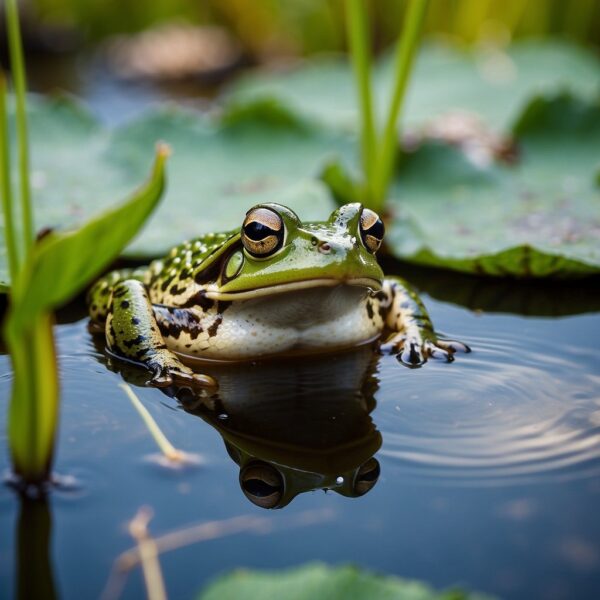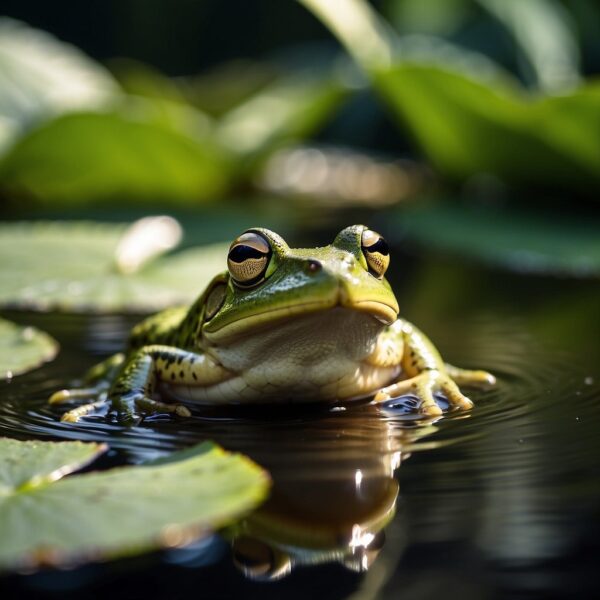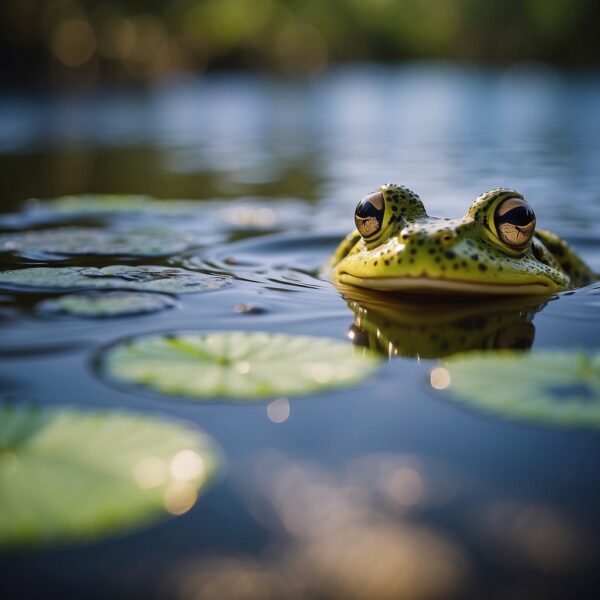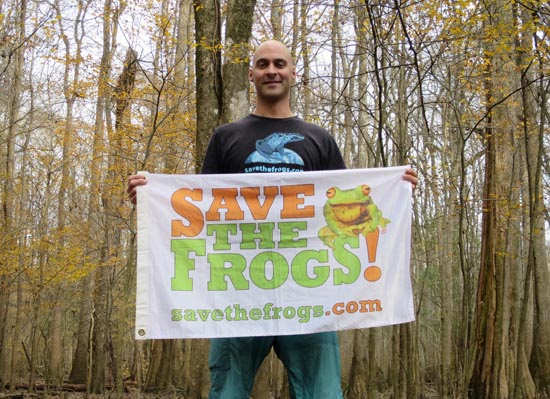
Why Amphibians Matter in Ecosystems
Today is World Frog Day! You might be wondering why I am writing about amphibians. My focus during my zoology studies was on big cat conservation. The big cats are considered charismatic megafauna. The term charismatic megafauna refers to large well-known animal species attracting a disproportionate share of the public’s attention. The tiger is the world’s most popular animal according to a survey conducted by Animal Planet. The big cat even beat out the dog for the number one position. These species have the “it” factor grabbing the public’s attention and desire to save them. The koala certainly is charming, but a small toad…perhaps not.
What about all the living beings that aren’t cute and cuddly or fierce and admired. Driving one day, I thought about toads. I wondered why frogs seem to be the preferred amphibian. I imagined a young toad named Andrew. I wish I could tell you why his name is Andrew but I honestly don’t know. I began to tell Gracey, she was a great listener, the story of a Andrew the young toad who wondered if his life might have been better had be been hatched a frog. And that is how An Ordinary Toad’s Extraordinary Night came to be.

When the story was completed, I asked Dr. Kriger, founder of Save The Frogs, if he would fact check for me to make sure that I had the differences and similarities between toads and frogs accurate. We were honored that he agreed and even wrote a kind review for us.
“An Ordinary Toad’s Extraordinary Night is not only an enjoyable read, it’s a great introduction to the natural history of amphibians.”
Thank you Dr. Kriger for caring about frogs and toads. And thank you for caring about all animals big and small. Now let’s learn more about World Frog Day and the vital role amphibians play in our eco-system.
WORLD FROG DAY!
World Frog Day, celebrated on March 20, draws attention to the diverse group of amphibians populating our planet, which play a crucial role in ecological systems worldwide. These amphibians are important for various reasons: they serve as indicators of environmental health, control insect populations, and their skin has substances that have medicinal properties. The day aims to raise awareness about the unique position of frogs in the ecosystem and the threats they face, which range from habitat destruction and pollution to diseases like chytridiomycosis.
The well-being of frogs is closely tied to the health of the environment. By monitoring frogs and addressing the conservation challenges they face, we can ensure not only their survival but also the vitality of our own natural world. Education and research are fundamental in fostering an understanding of amphibian biology, their role within the ecosystem, and human influences on their populations. World Frog Day represents an opportunity to reflect on these relationships and advance conservation efforts to protect these critical species for future generations.
Key Takeaways
- World Frog Day promotes the significance of frogs and amphibians.
- Amphibian conservation benefits both global biodiversity and human interests.
- Education and research on frogs underline the urgency of preservation initiatives.
The Importance of Frogs in the Ecosystem
Frogs play a pivotal role in maintaining ecological balance through their contributions as both predators and prey, and as sensitive indicators of environmental health. Their well-being is often reflective of the overall health of the ecosystem.
Role in Food Webs
Frogs are crucial components in food webs, particularly in tropical rainforests and various freshwater ecosystems. They help control insect populations, serving as a primary food source for a multitude of animals. By consuming a wide variety of prey, including insects that are considered pests to humans, frogs aid in regulating these populations and thereby support agricultural health and reduce vector-borne diseases.
Trophic levels where frogs contribute:
- As predators: Consume vast numbers of insects and other small invertebrates.
- As prey: Provide sustenance for higher trophic level species, such as birds, reptiles, and mammals.
The loss of frog species could result in overpopulation of their prey, leading to a range of adverse effects on the ecosystem integrity and agricultural productivity.
Environmental Indicators
Frogs are regarded as environmental indicators because of their sensitivity to pollutants and habitat changes. Changes in frog populations can signal alterations in environmental conditions, often related to climate change or global warming effects. Scientists study these changes to monitor environmental health and predict shifts in biodiversity.
Key characteristics of frogs as indicators:
- Permeable skin: Allows substances from the environment to easily enter their bodies, making them susceptible to toxins and pollutants.
- Life cycle: Encompasses aquatic and terrestrial habitats, thereby serving as a gauge for both environments.
- Temperature-dependent reproduction: Renders frogs sensitive to climate variations, with potential impacts on breeding success rates.
Their dual life stages and wide geographical distribution make them an important gauge for scientists studying the impacts of environmental stressors on species’ survival and biodiversity conservation.

Challenges Facing Amphibians on World Frog Day
Amphibians are experiencing a rapid decline, primarily due to habitat loss, diseases, and other anthropogenic factors. These stresses contribute to a grim outlook for many amphibian species globally.
Habitat Loss and Destruction
Habitat loss is one of the most pressing issues amphibians face. The destruction of wetlands for agriculture or urban development directly removes the breeding and living spaces essential for their survival. Habitat destruction also occurs due to logging and mining, which alter the landscape significantly, leading to the loss of native plants that are crucial for maintaining the balance of delicate ecosystems where amphibians thrive.
- Climate change further exacerbates habitat loss by altering weather patterns, resulting in habitats that are no longer suitable for local amphibian populations.
- Pollution, including agricultural runoff and chemical contaminants, can lead to both direct and indirect adverse effects on amphibian health and their environments.
Diseases Affecting Amphibian Populations
Amphibian populations are severely impacted by a variety of diseases; however, chytridiomycosis, caused by the chytrid fungus Batrachochytrium dendrobatidis, stands out as a major factor in the decline and extinction of many species.
- This fungal infection disrupts the amphibian skin’s function, often resulting in death.
- Fungal pathogens like the chytrid fungus thrive in moist conditions and are facilitated by international trade, making disease control challenging.
- Fungal infections are particularly troubling as they can spread rapidly and are difficult to detect, often recognized only after significant population declines have occurred.

Conservation Efforts
In tackling the decline of frog populations worldwide, conservation efforts have become crucial. Effective strategies are employed by various organizations to protect these critical species through direct action, education, and legal protection measures.
Amphibian Conservation Action
The Amphibian Conservation Action Plan (ACAP) serves as a global guide for amphibian conservation efforts. It recommends targeted actions such as habitat conservation, research, and disease management to help stabilize and improve amphibian populations. Major organizations, including the Amphibian Survival Alliance, coordinate efforts across regions, focusing on both in-situ and ex-situ conservation methods to protect these habitats and species.
- In-situ methods: protection of natural habitats, establishment of nature reserves
- Ex-situ methods: captive breeding programs, genetic research
World Frog Day: the Public and Raising Awareness
Public engagement and awareness are pivotal for the protection of amphibians. Initiatives like “Save The Frogs” emphasize amphibian education and encourage local communities to get involved. These initiatives often inspire volunteer work and education programs tailored to raise awareness about the plight of amphibians.
- Education Programs: workshops in schools, community presentations
- Volunteer Opportunities: habitat restoration projects, citizen science programs
Protecting Endangered and Threatened Species
Legal protection for endangered and threatened frog species is critical. Many species benefit from international and national laws that limit trade and land development, offering a legal safety net for these amphibians. Conservation efforts specifically aim to protect the most vulnerable groups, including critically endangered species, through legal means such as the Endangered Species Act.
- Legal Protections: trade regulations, critical habitat designation
- Targeted Actions for Threatened Species: recovery plans for individual species, anti-poaching patrols

Understanding Amphibian Biology
Amphibian biology is a complex field that examines the distinctive adaptations and life cycles of these creatures. Frogs, as a key group within amphibians, display a range of behaviors and reproductive strategies that are crucial for their survival.
Unique Adaptations and Behaviors
Amphibians are renowned for their dual life stages, typically starting as aquatic tadpoles before metamorphosing into terrestrial adults. This transition is a hallmark of amphibian biology, particularly within the order Anura, which includes frogs and toads. Amphibians also exhibit a variety of unique adaptations. For example, some species have developed poison glands as a defense mechanism against predators, while others can absorb water and oxygen directly through their skin. Their behaviors are equally varied; male frogs are known for their vocal calls, which are used to attract females during the breeding season.
Frog Populations and Reproduction
The reproduction of frogs is a critical aspect of their biology, influencing population dynamics and species survival. A single female frog can lay thousands of eggs, which she typically deposits in water. After hatching, tadpoles undergo a remarkable transformation, where they develop limbs and lungs to adapt to a terrestrial lifestyle. The reproductive success of frogs, however, is sensitive to environmental conditions, and changes can impact frog populations. Factors such as habitat destruction and climate change have been linked to declines in amphibian populations globally. Understanding these trends is essential for conservation efforts.
Human Influence and Amphibians
Human activities, particularly through agriculture, pollution, and urban development, have significantly affected amphibian populations. These changes have disrupted natural habitats and migration patterns essential for their survival.
Impact of Agriculture and Pollution
Agriculture contributes to habitat loss and destruction as natural environments are converted into farmland. The use of pesticides and fertilizers introduces harmful pollutants into the aquatic and terrestrial ecosystems where amphibians thrive. These pollutants can lead to lethal and sub-lethal effects on amphibian species, disrupting their reproductive and growth cycles.
- Habitat Destruction:
- Conversion of forests and wetlands into agricultural land.
- Drainage of ponds and wetlands for irrigation purposes.
- Pollution:
- Pesticides can cause deformities and death in amphibians.
- Fertilizers lead to eutrophication, degrading water quality in habitats.
Urban Development and Amphibian Migration
Urban development causes immense pressure on amphibian populations by fragmenting their habitats and creating barriers to migration. Roads and buildings cut through wetlands and forests, often severing the crucial corridors that amphibians, such as migrating toads and frogs, use to reach their breeding grounds.
- Migration Barriers:
- Roads and infrastructure disrupt the natural migration pathways.
- Amphibians are exposed to vehicle-related mortality while attempting to cross these barriers.
- Fragmentation:
- Small, isolated populations are less viable and more susceptible to local extinctions.
- Urban encroachment leads to increased predation and competition for limited resources.

Research and Education
Academic Contributions to Amphibian Studies
Researchers, including professors like Heather Bateman, a field ecologist at Arizona State University’s College of Integrative Sciences and Arts, have been instrumental in advancing our understanding of amphibian biology and ecology. Their work often leads to identifying critical conservation needs and facilitating amphibian preservation efforts.
- Research Focus: Amphibians serve as bioindicators of environmental quality, and their study can signal changes in biodiversity and the presence of pollutants.
- Conservation Efforts: Academic research informs conservation strategies to mitigate the effects of habitat destruction, climate change, and diseases such as chytridiomycosis, which devastates amphibian populations worldwide.
The integration of amphibian studies into college curricula underscores the importance of conserving these creatures, while also preparing the next generation of environmental scientists.
World Frog Day: Community Outreach and Involvement
Education extends beyond the classroom into the heart of local communities, where awareness and volunteer activities play a central role in amphibian conservation.
- Amphibian Education: Frog enthusiasts and educators organize workshops and field trips, promoting knowledge about local amphibian species among community members.
- Volunteer Programs: Engaging the public through citizen science projects, such as local amphibian surveys, contributes to critical data collection while fostering a connection to the natural world.
By involving local communities through education and volunteer work, awareness about the fragility and importance of amphibian populations is heightened, supporting broader conservation efforts.
Global Impact and Initiatives
The survival of amphibians is critical to global ecosystem health. Conservation initiatives and strategic partnerships play pivotal roles in safeguarding these species.
International Conservation Strategies
International conservation strategies involve a coordinated effort among nations to address the rapid decline of amphibian populations. This facilitates the sharing of best practices and the development of unified policies. Key strategies include:
- Habitat Protection: Ensuring the conservation of wetlands, forests, and other critical amphibian habitats.
- Legislation: Enacting and enforcing laws to prevent illegal trade and over-exploitation of amphibians.
World Frog Day: Partnerships for Amphibian Survival
Strong partnerships are essential to amplify conservation efforts. They bring together various stakeholders, including:
- Save The Frogs: Founded in 2008 by amphibian biologist Dr. Kerry Kriger, SAVE THE FROGS! is the world’s most effective amphibian conservation organization.
- The Amphibian Survival Alliance (ASA): The largest collaborative effort for amphibian conservation, striving to protect these species through partnerships and coordinated action.
- Non-Governmental Organizations (NGOs): They play a significant role by providing research, funding, and on-the-ground conservation action.

Frequently Asked Questions
This section aims to address common inquiries regarding the significance and roles of amphibians within various environmental and scientific contexts.
What role do amphibians play in ecosystems?
Amphibians are crucial in ecosystems as they serve as both predators and prey. Their larval stages often consume algae, helping control algal blooms, while adults predate on insects, regulating their populations.
How do frogs contribute to biodiversity?
Frogs enhance biodiversity through their diverse roles in food webs and their vast array of species, each adapted to specific ecological niches. This diversity stabilizes ecosystems and fosters a greater range of plant and animal life.
In what ways are amphibians important for scientific research?
Amphibians are vital models in scientific research due to their sensitive development, often used to study embryology, evolution, and the impact of environmental changes on vertebrate life.
What impact do amphibians have on controlling insect populations?
Amphibians, especially frogs and toads, are natural pest controllers as they consume large quantities of insects, including agricultural pests, thereby reducing the need for chemical pesticides.
How does the presence of amphibians help in monitoring environmental changes?
The presence of amphibians, such as their population patterns and health, can indicate environmental changes since they readily absorb substances from their surroundings, making them effective bioindicators.
Why is the conservation of amphibian habitats vital?
Conserving amphibian habitats is vital as it ensures the survival of these species that maintain ecological balance, support biodiversity, and provide essential research insights into environmental health.